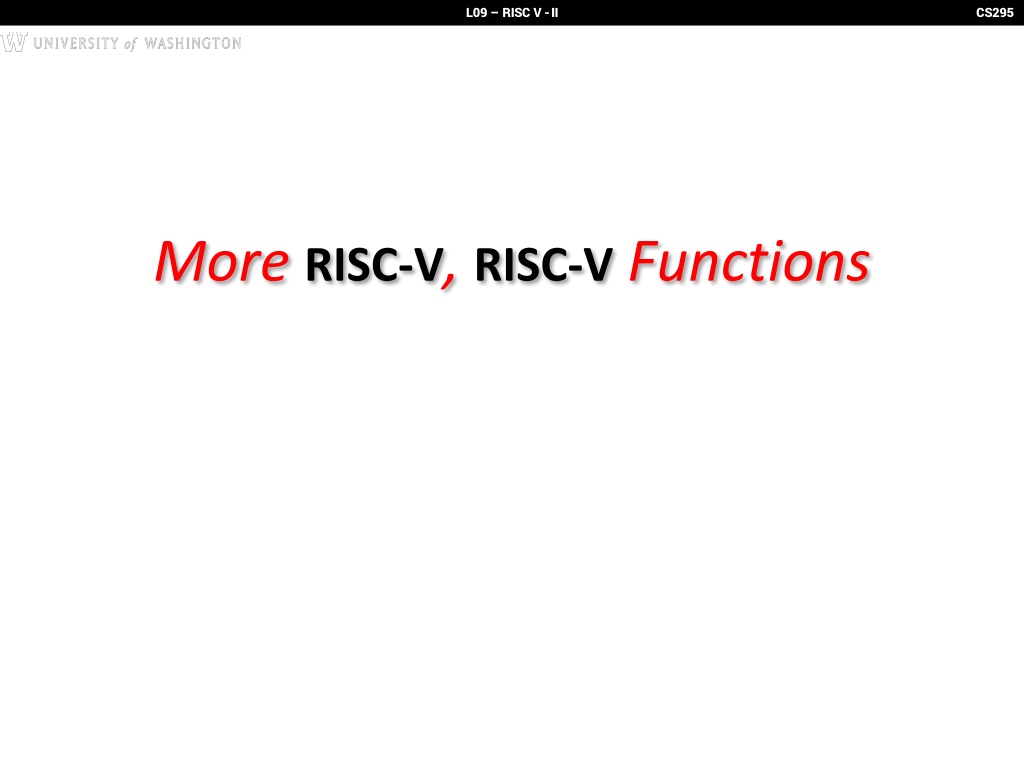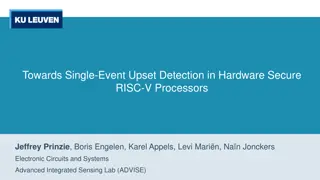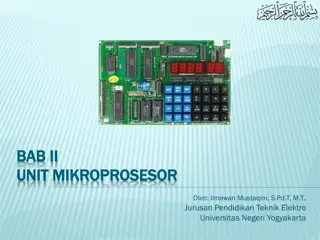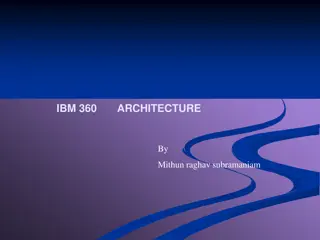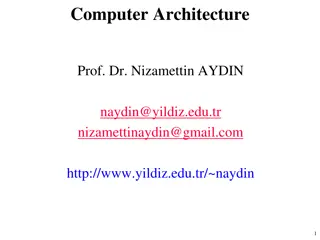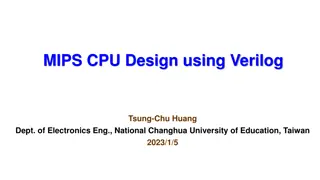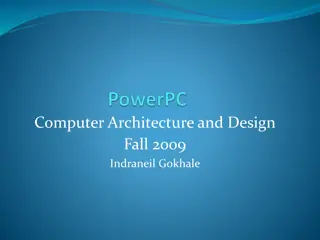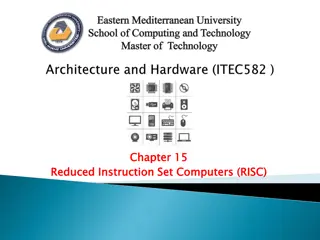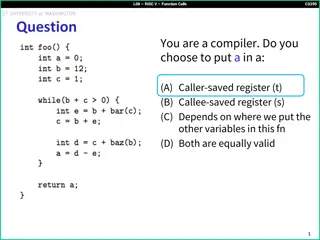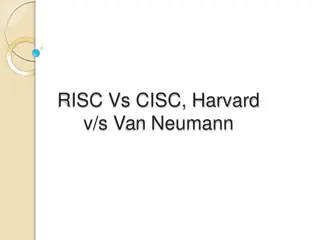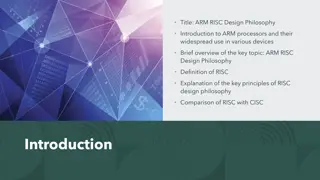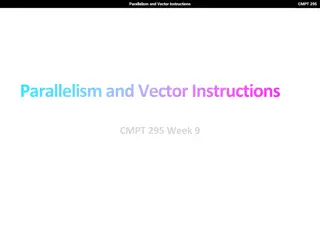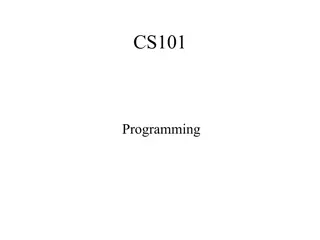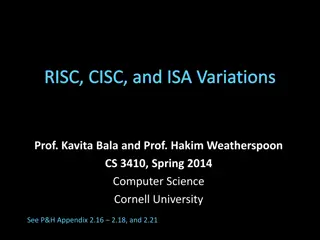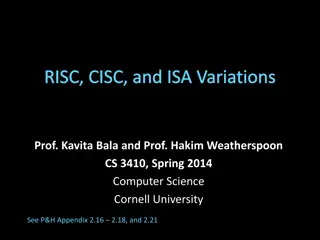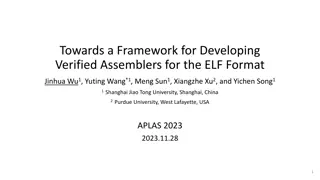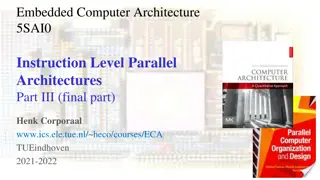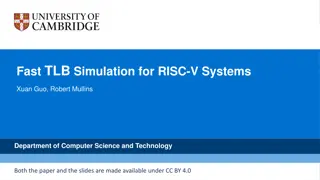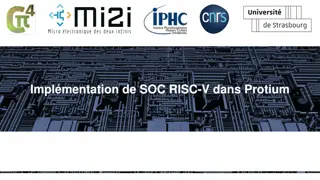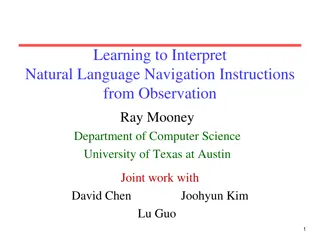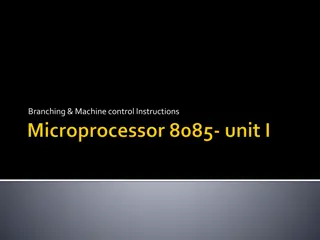RISC-V Principles and Instructions
This content covers essential topics related to RISC-V architecture, including design principles, registers, instructions for arithmetic, data transfer, branching, and bitwise operations. Additionally, it explores memory management, variable size handling, trading bytes with memory, and endianness concepts like Big and Little Endian. The use of byte instructions, memory access methods, and examples are also discussed in detail, providing a comprehensive overview of RISC-V concepts.
Download Presentation

Please find below an Image/Link to download the presentation.
The content on the website is provided AS IS for your information and personal use only. It may not be sold, licensed, or shared on other websites without obtaining consent from the author.If you encounter any issues during the download, it is possible that the publisher has removed the file from their server.
You are allowed to download the files provided on this website for personal or commercial use, subject to the condition that they are used lawfully. All files are the property of their respective owners.
The content on the website is provided AS IS for your information and personal use only. It may not be sold, licensed, or shared on other websites without obtaining consent from the author.
E N D
Presentation Transcript
L09 RISC V -II CS295 More RISC-V, RISC-V Functions
L09 RISC V -II CS295 Summary RISC Design Principles Smaller is faster: 32 registers, fewer instructions Keep it simple: rigid syntax RISC-V Registers: s0-s11, t0-t6, x0 No data types, just raw bits, operations determine how they are interpreted Memory is byte-addressed no types no automatic pointer arithmetic 2
L09 RISC V - II CS295 RISC-V Instructions Arithmetic: add, sub, addi, Data Transfer: lw,sw, Branching: jal; Bitwise: Shifting: i= immediate (constant integer) mult,div lb, sb, lbu beq, bne, j, bge, blt, and, or, xor, andi, ori, xori sll, srl, sra, slli, srli, srai 3
L09 RISC V - II CS295 Memory and Variable Size So Far: lw reg, off(bAddr) sw reg, off(bAddr) Computer Processor Control ( brain ) Devices Input Memory lw reg off(bAddr) Output sw reg off(bAddr) Datapath Registers What about characters (1B) and shorts (sometimes 2B), etc? Want to be able to use interact with memory values smaller than a word. 4
L09 RISC V - II CS295 Trading Bytes with Memory (2 approaches) Method 1: Move words in and out of memory using bit-masking and shifting lw s0,0(s1) andi s0,s0,0xFF # lowest byte Method 2: Load/store byte instructions lb s1,1(s0) sb s1,0(s0) *(s0) = 0x00000180 00 00 01 80 5
L09 RISC V - II CS295 Endianness Big Endian: Most-significant byte at least address of word word address = address of most significant byte Little Endian: Least-significant byte at least address of word word address = address of least significant byte *(s0) = 0x00000180 big endian 0(s0) 00 1(s0) 00 2(s0) 01 3(s0) 80 msb lsb 3(s0) 2(s0) 1(s0) 0(s0) little endian RISC-V is Little Endian 6
L09 RISC V - II CS295 Byte Instructions lb/sb utilize the least significant byte of the register On sb, upper 24 bits are ignored On lb, upper 24 bits are filled by sign-extension For example, let *(s0) = 0x00000180: lb s1,1(s0) lb s2,0(s0) sb s2,2(s0) # *(s0)=0x00800180 # s1=0x00000001 # s2=0xFFFFFF80 7
L09 RISC V - II CS295 Half-Word Instructions lh reg, off(bAddr) load half sh reg, off(bAddr) store half On sh, upper 16 bits are ignored On lh, upper 16 bits are filled by sign-extension Unsigned Instructions lhu reg, off(bAddr) load half unsigned lbu reg, off(bAddr) load byte unsigned On l(b/h)u, upper bits are filled by zero-extension Why no s(h/b)u? Why no lwu? 8
L09 RISC V - II CS295 Agenda More Memory Instructions Inequalities Pseudo-Instructions Bonus: Memory Address Convention Bonus: Alternate Register Convention Analogy 9
L09 RISC V - II CS295 Inequalities in RISC-V Set Less Than (slt) slt dst,reg1,reg2 if value in reg1 < value in reg2, dst = 1, else 0 Set Less Than Immediate (slti) slti dst,reg1,imm If value in reg1 < imm, dst = 1, else 0 These values are all interpreted as signed values What if we want to compare unsigned numbers? 10
L09 RISC V - II CS295 Unsigned Inequalities Unsigned versions of slt(i): sltu dst,src1,src2: unsigned comparison sltiu dst,src,imm: unsigned comparison against constant Example: addi s0,x0,-1 slti t0,s0,1 sltiu t1,s0,1 # s0=0xFFFFFFFF # t0=1 (-1 < 1) # t1=0 (232-1 >>> 1) 11
L09 RISC V - II CS295 Aside: RISC-V Signed vs. Unsigned RISC-V terms signed and unsigned appear in 2 different contexts: Signed vs. unsigned bit extension lb,lh lbu,lhu Signed vs. unsigned comparison slt, slti sltu, sltiu 12
Question: What C code properly fills in the following blank? do {i--; } while((z = ____________)); Loop: # i s0, j s1 addi s0,s0,-1 # i = i - 1 slti t0,s1,2 # t0 = (j < 2) bne t0,x0 Loop slt t0,s1,s0 # t1 = (j < i) bne t0,x0 ,Loop # goto Loop if t0!=0 # goto Loop if t0!=0 j < 2 || j < i j 2 && j < i j < 2 || j i j < 2 && j i (A) (B) (C) (D) 13
Question: What C code properly fills in the following blank? do {i--; } while((z = ____________)); Loop: # i s0, j s1 addi s0,s0,-1 # i = i - 1 slti t0,s1,2 # t0 = (j < 2) bne t0,x0 Loop slt t0,s1,s0 # t1 = (j < i) bne t0,x0 ,Loop # goto Loop if t0!=0 # goto Loop if t0!=0 j < 2 || j < i j 2 && j < i j < 2 || j i j < 2 && j i (A) (B) (C) (D) 14
L09 RISC V - II CS295 Agenda More Memory Instructions Inequalities Administrivia Pseudo-Instructions Bonus: Memory Address Convention Bonus: Alternate Register Convention Analogy 15
L09 RISC V - II CS295 Assembler Pseudo-Instructions more intuitive for programmers, but NOT directly implemented in hardware translated later into instructions which are directly implemented in hardware Example: mv dst,reg1 translated into addi dst,reg1,0 or add dst,reg1,x0 Full list of RISC-V supported pseudo instructions are on the greensheet 16
L09 RISC V - II CS295 More Pseudo-Instructions Load Immediate (li) li dst,imm Loads 32-bit immediate into dst translates to: addi dst x0 imm Load Address (la) la dst,label Loads address of specified label into dst (translation omitted) 17
L09 RISC V - II CS295 J is a Pseudo-Instruction Even the j instruction is actually a pseudo- Instruction We will see what this converts to later this lecture Pseudo-Instructions are core to writing RISC assembly code and you will see it in any RISC assembly code you read 6/28/2016 18
L09 RISC V - II CS295 True Assembly vs RISC-V True Assembly Language The instructions a computer understands and executes (directly implemented in hardware!) RISC-V Assembly Language Instructions the assembly programmer can use (includes pseudo-instructions) Each RISC-V Assembly instruction becomes 1 or more True Assemblt instructions True Assembly RISC-V Assembly 19
